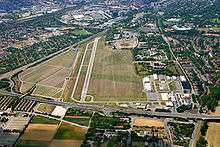Mannheim
Mannheim (German pronunciation: [ˈmanhaɪm] (![]()
Mannheim | |
|---|---|
    Friedrichsplatz, Jesuit Church, Luisenpark, Wasserturm, Augustaanlage | |
 Flag  Coat of arms | |
Location of Mannheim in Baden-Württemberg 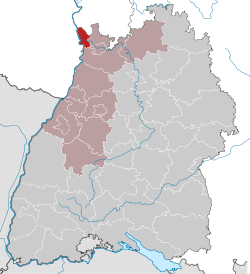 | |
 Mannheim  Mannheim | |
| Coordinates: 49°29′16″N 08°27′58″E | |
| Country | Germany |
| State | Baden-Württemberg |
| Admin. region | Karlsruhe |
| District | urban district |
| Government | |
| • Lord Mayor | Peter Kurz (SPD) |
| Area | |
| • City | 144.96 km2 (55.97 sq mi) |
| Elevation | 97 m (318 ft) |
| Population (2018-12-31)[1] | |
| • City | 309,370 |
| • Density | 2,100/km2 (5,500/sq mi) |
| • Metro | 2,362,046[2] |
| Time zone | CET/CEST (UTC+1/+2) |
| Postal codes | 68001–68309 |
| Dialling codes | 0621 |
| Vehicle registration | MA |
| Website | www.mannheim.de |
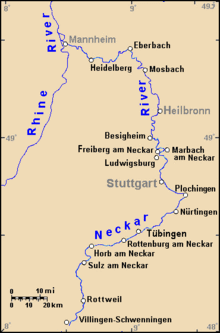
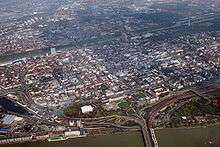
Mannheim is located at the confluence of the Rhine and the Neckar in the northwestern corner of Baden-Württemberg. The Rhine separates Mannheim from the city of Ludwigshafen, just to the west of it in Rhineland-Palatinate, and the border of Baden-Württemberg with Hesse is just to the north. Mannheim is downstream along the Neckar from the city of Heidelberg.
Mannheim is unusual among German cities in that its streets and avenues are laid out in a grid pattern, leading to its nickname "die Quadratestadt" ("The City of Squares"). The eighteenth century Mannheim Palace, former home of the Prince-elector of the Palatinate, now houses the University of Mannheim.
The city is home to major corporations including Daimler, John Deere, Caterpillar, ABB, Fuchs Petrolub, IBM, Roche, Reckitt Benckiser, Unilever, Phoenix Group, Siemens, and several other well-known companies. In addition, Mannheim's SAP Arena is not only the home of the German ice hockey record champions the Adler Mannheim, but also the well-known handball team, the Rhein-Neckar Löwen. According to the Forbes magazine, Mannheim is known for its exceptional inventive power and was ranked 11th among the Top 15 of the most inventive cities worldwide.[4][5] The New Economy Magazine elected Mannheim under the 20 cities that best represent the world of tomorrow emphasizing Mannheim's positive economic and innovative environment.[6] Since 2014, Mannheim has been a member of the UNESCO Creative Cities Network and holds the title of "UNESCO City of Music".[7] Mannheim is a Smart City; the city's electrical grid is installed with a power-line communication network.[8]
The city's tourism slogan is "Leben. Im Quadrat." (Life. Squared.) The civic symbol of Mannheim is der Wasserturm, a Romanesque water tower completed in 1886 that rises to 60 metres (200 feet) above the highest point of the art nouveau area Friedrichsplatz. Mannheim is the starting and finishing point of the Bertha Benz Memorial Route.
History
Early history
The name of the city was first recorded as Mannenheim in a legal transaction in 768, surviving in a twelfth-century copy in the Codex Laureshamensis from Lorsch Abbey. The name is interpreted as "the home of Manno", a short form of a Germanic name such as Hartmann or Hermann.[9] Mannheim remained a mere village throughout the Middle Ages.
Early Modern Age
In 1606, Frederick IV, Elector Palatine started building the fortress of Friedrichsburg and the adjacent city centre with its grid of streets and avenues. On 24 January 1607, Frederick IV gave Mannheim the status of a "city", whether it really was one by then or not.
Mannheim was mostly levelled during the Thirty Years War around 1622 by the forces of Johan Tilly. After being rebuilt, it was again severely damaged by the French Army in 1689 during the Nine Years' War.
After the rebuilding of Mannheim that began in 1698, the capital of the Electorate of the Palatinate was moved from Heidelberg to Mannheim in 1720 when Karl III Philip, Elector Palatine began construction of Mannheim Palace and the Jesuit Church; they were completed in 1760.
18th and 19th centuries
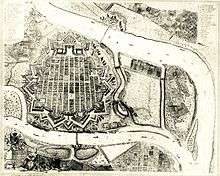
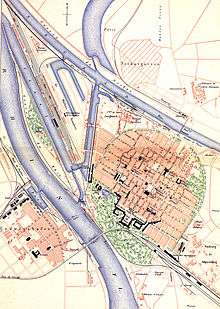
During the eighteenth century, Mannheim was the home of the "Mannheim School" of classical music composers. Mannheim was said to have one of the best court orchestras in Europe under the leadership of the conductor Carlo Grua. The royal court of the Palatinate left Mannheim in 1778. Two decades later, in 1802, Mannheim was removed from the Palatinate and given to the Grand Duchy of Baden.
In 1819, Norwich Duff wrote of Mannheim:
In 1819, August von Kotzebue was assassinated in Mannheim.
The climate crisis of 1816-17 caused famine and the death of many horses in Mannheim. That year Karl Drais invented the first bicycle.
Infrastructure improvements included the establishment of Rhine Harbour in 1828 and construction of the first Baden railway, which opened from Mannheim to Heidelberg in 1840. Influenced by the economic rise of the middle class, another golden age of Mannheim gradually began. In the March Revolution of 1848, the city was a centre for political and revolutionary activity.
In 1865, Friedrich Engelhorn founded the Badische Anilin- und Soda-Fabrik (Baden Aniline and Soda Factory, BASF) in Mannheim, but the factory was constructed across the Rhine in Ludwigshafen because Mannheim residents feared air pollution from its operations. From this dye factory, BASF has developed into the largest chemical company in the world. After opening a workshop in Mannheim in 1871 and patenting engines from 1878, Karl Benz patented the first motor car in 1886. He was born in Mühlburg (now part of Karlsruhe).
Early 20th century and World War I
The Schütte-Lanz company, founded by Karl Lanz and Johann Schütte in 1909, built 22 airships. The company's main competitor was the Zeppelin works.
When World War I broke out in 1914, Mannheim's industrial plants played a key role in Germany's war economy. This contributed to the fact that, on 27 May 1915, Ludwigshafen was the world's first civilian settlement behind the battle lines to be bombed from the air. French aircraft attacked the BASF plants, thereby killing twelve people. The precedent was set for this attack by Germany's repeated air raids against British civilian populations throughout southeastern Britain during the first half of 1915.
When Germany lost the war in 1918, according to the peace terms, the left bank of the Rhine was occupied by French troops. The French occupation lasted until 1930, and some of Ludwigshafen's most elegant houses were erected for the officers of the French garrison.
Inter-war period
After the First World War, the Heinrich Lanz Company built the Bulldog, an advanced tractor, powered by heavy oil. As a result of the invention of the pre-combustion chamber by Prosper L'Orange, Benz & Cie. developed the world's first compact diesel-powered car at its motor works in Mannheim in 1923. In 1922, the Grosskraftwerk Mannheim (Mannheim large power station) was opened. By 1930, the city, along with its sister city of Ludwigshafen, which had developed out of the old Mannheim Rheinschanze, had a population of 385,000.
World War II
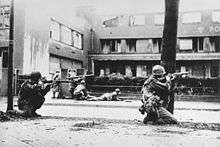
During WW2, air raids on Mannheim completely destroyed the city centre. Mannheim was heavily damaged during aerial bombing by the RAF and the U.S. Air Force. The RAF razed the city center of Mannheim with nighttime area bombing killing thousands of civilians. 2,262 of Mannheim's Jews were sent to concentration camps. Some sources state that the first deliberate terror bombing of the war occurred at Mannheim on 16 December 1940.[10]
The Allied ground advance into Germany reached Mannheim in late March 1945, which was potentially well-defended by German forces. However, the German forces suddenly abandoned the city and the U.S. 44th Infantry Division entered unopposed on 29 March 1945.[11] There had been a large American military occupation presence in the Mannheim area with up to 10 barracks. The first one shut down in 2007 going on until 2013 when the last one closed. (See United States military installations below).
1950s to 1980s
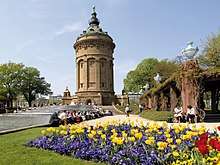

Rebuilding of the city began laboriously. Mannheim Palace and the water tower (Wasserturm) eventually were rebuilt and the National Theatre was replaced by a new building at a new location. At the old location there is a monument to Friedrich Schiller and the Zum Zwischen-Akt pub. The housing shortage led to the development of many new residential areas.
In 1964, the City Hospital (Städtische Krankenhaus) became part of the Neckar Faculty of Heidelberg University for Clinical Medicine in Mannheim. In 1967, the University of Mannheim was established in the city.
In 1975, the Bundesgartenschau (Federal horticulture show) was celebrated in Luisen and Herzogenried parks. A number of pieces of infrastructure were developed for the show: the telecommunications tower and a second bridge across the Rhine were built, the pedestrian zone was established, the new Rosengarten conference centre was opened and the Aerobus was installed as a temporary transport system.
A number of major projects were completed in the 1980s and 1990s: a planetarium, an extension to the art gallery, the new Reiß Museum, Stadthaus, a new May Market ground, synagogue, mosque, State Museum for Technology and Work, Carl-Benz stadium and the Fahrlach tunnel were opened.
Mannheim has lost many industrial jobs, although in the recent past the city was economically dominated by manufacturing. The city tried in the past to prevent the establishment of service providers by designating some locations as industrial areas. A prime example of the current trend is the construction of the Victoria Tower (Victoria-Turm) in 2001, one of the tallest buildings in the city, on railway land.
Post-reunification
Mannheim celebrated its 400th anniversary with a series of cultural and other events throughout 2007. The 400th anniversary proper was in 2006, since Frederick IV, Elector Palatine laid the foundations of Mannheim citadel on 17 March 1606. In preparation for the anniversary, some urban activities were implemented, beginning in 2000: the building of the SAP Arena with access to the city's new eastern ring road, the rehabilitation of the pedestrian zone in Breite Straße, the arsenal and the palace, the complete transformation of the old fair ground, and the new Schafweide tram line. The concept of the anniversary of the city aimed at a diverse range of events without a dominant central event.
Demographics
| Year | Pop. | ±% |
|---|---|---|
| 1450 | 570 | — |
| 1663 | 3,000 | +426.3% |
| 1777 | 25,353 | +745.1% |
| 1802 | 18,818 | −25.8% |
| 1871 | 39,606 | +110.5% |
| 1900 | 141,131 | +256.3% |
| 1919 | 229,576 | +62.7% |
| 1925 | 247,486 | +7.8% |
| 1933 | 275,162 | +11.2% |
| 1939 | 284,957 | +3.6% |
| 1950 | 245,634 | −13.8% |
| 1961 | 313,890 | +27.8% |
| 1970 | 332,163 | +5.8% |
| 1987 | 295,191 | −11.1% |
| 2011 | 290,117 | −1.7% |
| 2017 | 307,997 | +6.2% |
| source:[12] | ||
The following list shows significant groups of foreigners in the city of Mannheim by nationalities.[13] In total 44,7% of all Mannheim inhabitants are from foreign descent. With 68,9% in the Neckarstadt-West district the population is the most foreign, in the Wallstadt district with 23,1% it is the least.
| Rank | Nationality | Population (31.12.2019) |
|---|---|---|
| 1 | 16,102 | |
| 2 | 8,209 | |
| 3 | 6,822 | |
| 4 | 6,638 | |
| 5 | 5,575 | |
| 6 | 4,502 | |
| 7 | 3,386 | |
| 8 | 1,740 | |
| 9 | 1,646 | |
| 10 | 1,529 | |
| 11 | 1,467 | |
| 12 | 1,403 | |
| 13 | 1,223 | |
| 14 | 1,190 | |
| 15 | 1,086 | |
| 16 | 1,028 | |
| 17 | 974 | |
| 18 | 937 | |
| 19 | 902 | |
| 20 | 804 | |
Inventions
Some important inventions were made in Mannheim.
- Karl Drais built the first two-wheeled draisine in 1817.
- Karl Benz drove the first automobile on the streets of Mannheim in 1886. At his workshop in Mannheim he produced a lightweight three-wheeled vehicle powered by a single cylinder petrol/gasoline-fueled engine, first shown in public during 1886. This powered tricycle subsequently came to be widely regarded as the first automobile/motor car powered by an internal-combustion engine. Karl's wife Bertha Benz undertook the world's first road trip by automobile from Mannheim to Pforzheim in August 1888.
- The Lanz Bulldog, a popular tractor with a rugged, simple Diesel engine was introduced in 1921.
- Karl Benz developed the world's first compact diesel-powered car at the Benz & Cie. motor works in Mannheim during 1923.
- Julius Hatry built the world's first rocket plane in 1929.
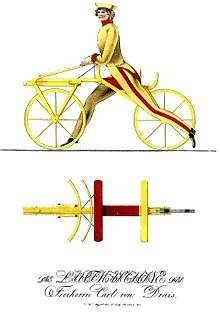 The world's first bicycle, built in Mannheim by Karl Freiherr von Drais in 1817
The world's first bicycle, built in Mannheim by Karl Freiherr von Drais in 1817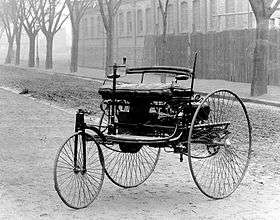 The world's first motorcar, built in Mannheim by Karl Benz in 1885
The world's first motorcar, built in Mannheim by Karl Benz in 1885 Official sign of Bertha Benz Memorial Route, commemorating the world's first long-distance journey by automobile from Mannheim to Pforzheim in 1888 104 km (65 mi)
Official sign of Bertha Benz Memorial Route, commemorating the world's first long-distance journey by automobile from Mannheim to Pforzheim in 1888 104 km (65 mi)
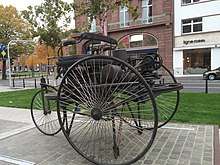
Politics
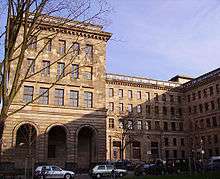
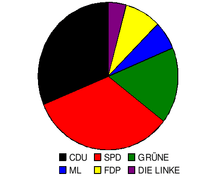
City council
The council has 48 seats and is elected by direct suffrage for five years. In the local elections in Baden-Württemberg, voters are allowed to take advantage of cumulative voting and vote splitting. Since the Second World War the SPD, except in the elections of 1999 and 2004, has received more votes than the CDU. At the 2019 election the Greens received most votes for the first time. The next municipal election will take place in 2024.
The outcome of the local elections of 25 May 2019 and the current members of the council is as follows:[14]
| City Council election 2019 | ||||
|---|---|---|---|---|
| Greens | ||||
| SPD | ||||
| CDU | ||||
| AfD | ||||
| Free Voters/Mannheim List | ||||
| FDP | ||||
| The Left | ||||
| Die PARTEI | ||||
| Mittelstand für Mannheim | ||||
| APP | ||||
| Others | ||||

Mayor
The mayor is the head of the city council and chairman of the council, being selected by direct suffrage for a term of eight years. The current mayor is Peter Kurz (SPD), who was elected during 2007 with 50.53 percent on a turnout of 36.64 percent in the first round. Kurz was reelected in 2015 with 52 percent in the second round.
The city leaders since 1810 are:
- 1810–1820: Johann Wilhelm Reinhardt
- 1820–1832: Valentin Möhl
- 1833–1835: Heinrich Andriano
- 1836–1849: Ludwig Jolly
- 1849–1852: Friedrich Reiß
- 1852–1861: Heinrich Christian Diffené
- 1861–1870: Ludwig Achenbach
- 1870–1891: Eduard Moll
- 1891–1908: Otto Beck
- 1908–1913: Paul Martin
- 1914–1928: Theodor Kutzer
- 1928–1933: Hermann Heimerich (SPD)
- 1933–1945: Carl Renninger (NSDAP)
- 1945–1948: Josef Braun (CDU)
- 1948–1949: Fritz Cahn-Garnier (SPD)
- 1949–1955: Hermann Heimerich (SPD)
- 1956–1972: Hans Reschke (independent)
- 1972–1980: Ludwig Ratzel (SPD)
- 1980–1983: Wilhelm Varnholt (SPD)
- 1983–2007: Gerhard Widder (SPD)
- since 2007: Peter Kurz (SPD)
United States military installations
A number of U.S. Army Europe installations were located in and near Mannheim during the Cold War. The following locations provided services to and housed the "U.S. Army Garrison Mannheim" and other units of the U.S. Army. The U.S. Army Garrison Mannheim was formally deactivated on 31 May 2011.[15]
- Coleman Barracks and Coleman Army Airfield (Mannheim-Sandhofen): The headquarters of the American Forces Network-Europe, and the home of the Army's 28th Transportation Battalion. Also, the location of the United States Army Corrections Facility-Europe.
- Funari Barracks (Mannheim-Käfertal), vacated in 2014.
- Spinelli Barracks (Mannheim-Feudenheim), vacated in 2015.
- Sullivan Barracks (Mannheim-Käfertal): formerly the headquarters of the U.S. Army's 7th Signal Brigade and the 529th Military Police Honor Guard Company's 2nd Platoon; vacated in 2014.
- Taylor Barracks (Mannheim-Vogelstang): formerly the headquarters of the U.S. Army's 2nd Signal Brigade; vacated in 2011.
- Turley Barracks (Mannheim-Käfertal): in the early 1990s was home to the 181st Transportation Bn, with companies of 40th, 41st, 51st, 590th, TTP, and HHC transportation companies and also the headquarters of the NATO ACE Mobile Force (Land) (AMFL).
- The Benjamin Franklin Village (Mannheim-Käfertal), housing. Also, it was the home of the Mannheim American High School and the Middle School,[16] which closed on 9 June 2011. The last soldier and his family moved out in 2012.
The following locations were part of the "U.S. Army Garrison Heidelberg" but were within the area of the city of Mannheim; They were vacated in 2010 and 2011:
- Friedrichsfeld Service Center (Mannheim-Friedrichsfeld)
- Hammonds Barracks (formerly Loretto Kaserne) (Mannheim-Seckenheim)
- Stem Kaserne (Mannheim-Seckenheim)
All personnel of the U.S. Army military community left Mannheim by 2015, some of them moving to Wiesbaden. With the exception of four barracks, all other barracks formerly occupied by the U.S. military had been returned to the German state for conversion to civilian use in 2011.
Theatre
The National Theatre Mannheim was founded in 1779 and is the oldest "Stage" in Germany. In 1782 the premier of Die Räuber, written by Friedrich Schiller, was shown.
Recently, more smaller stages have opened, such as the Oststadt-Theater, the TIG7 (Theater im Quadrat G7), the Theater Oliv, the Freilichtbühne, the Theater31, the Theater ImPuls, the Theater Felina-Areal, the Mannheimer Puppenspiele, the Kleinkunstbühne Klapsmühl', Schatzkistl, and zeitraumexit.
Education
The University of Mannheim is one of Germany's younger universities. Although founded in 1967, it has its origins in the 1763-established Palatine Academy of Sciences and the former Handelshochschule. Situated in Mannheim Palace, it is Germany's leading university in business and economics and attracts students from around the world. Described by "Die Zeit" magazine as the 'Harvard of Germany' it is seen as the alma mater of German businessmen and women.

The university town also houses one of the medical schools of Heidelberg University, the Hochschule Mannheim, a branch of the Duale Hochschule of the State of Baden-Württemberg and several musical and theatrical academies, including the Pop Academy Mannheim, the Musikhochschule and the Theaterakademie. These institutions draw a large and diverse student body.
Dependents of U.S. military personnel attended Mannheim Elementary School until it closed in June 2012.[17] In the 1980s the school had 2,200 students.[18]
Geography
Climate
| Climate data for Mannheim, Germany for 1981–2010 (Source: DWD) | |||||||||||||
|---|---|---|---|---|---|---|---|---|---|---|---|---|---|
| Month | Jan | Feb | Mar | Apr | May | Jun | Jul | Aug | Sep | Oct | Nov | Dec | Year |
| Record high °C (°F) | 16.4 (61.5) |
20.2 (68.4) |
26.1 (79.0) |
32.0 (89.6) |
33.2 (91.8) |
38.9 (102.0) |
39.0 (102.2) |
39.8 (103.6) |
34.3 (93.7) |
28.5 (83.3) |
22.6 (72.7) |
17.5 (63.5) |
39.8 (103.6) |
| Average high °C (°F) | 4.7 (40.5) |
6.7 (44.1) |
11.6 (52.9) |
16.2 (61.2) |
20.6 (69.1) |
23.7 (74.7) |
26.1 (79.0) |
25.9 (78.6) |
21.2 (70.2) |
15.3 (59.5) |
8.9 (48.0) |
5.3 (41.5) |
15.50 (59.90) |
| Daily mean °C (°F) | 1.8 (35.2) |
2.8 (37.0) |
6.7 (44.1) |
10.7 (51.3) |
15.2 (59.4) |
18.2 (64.8) |
20.3 (68.5) |
19.9 (67.8) |
15.6 (60.1) |
10.7 (51.3) |
5.7 (42.3) |
2.8 (37.0) |
10.85 (51.53) |
| Average low °C (°F) | −1.3 (29.7) |
−0.8 (30.6) |
2.3 (36.1) |
5.0 (41.0) |
9.4 (48.9) |
12.4 (54.3) |
14.5 (58.1) |
14.2 (57.6) |
10.6 (51.1) |
6.7 (44.1) |
2.5 (36.5) |
-0.0 (32.0) |
6.28 (43.30) |
| Record low °C (°F) | −18.7 (−1.7) |
−21.1 (−6.0) |
−13.6 (7.5) |
−6.4 (20.5) |
−0.1 (31.8) |
4.0 (39.2) |
4.7 (40.5) |
5.3 (41.5) |
2.5 (36.5) |
−5.0 (23.0) |
−8.7 (16.3) |
−18.3 (−0.9) |
−21.1 (−6.0) |
| Average precipitation mm (inches) | 40.9 (1.61) |
43.1 (1.70) |
50.8 (2.00) |
49.3 (1.94) |
72.5 (2.85) |
66.6 (2.62) |
76.0 (2.99) |
57.7 (2.27) |
54.1 (2.13) |
56.4 (2.22) |
53.5 (2.11) |
54.1 (2.13) |
675.0 (26.57) |
| Mean monthly sunshine hours | 55.2 | 85.6 | 124.0 | 180.2 | 214.1 | 219.1 | 235.1 | 222.1 | 164.1 | 108.8 | 59.0 | 44.9 | 1,712.2 |
| Source: Data derived from Deutscher Wetterdienst[19] | |||||||||||||
| Climate data for Mannheim 2019-present | |||||||||||||
|---|---|---|---|---|---|---|---|---|---|---|---|---|---|
| Month | Jan | Feb | Mar | Apr | May | Jun | Jul | Aug | Sep | Oct | Nov | Dec | Year |
| Average high °C (°F) | 7.2 (45.0) |
11.3 (52.3) |
13.0 (55.4) |
19.1 (66.4) |
19.3 (66.7) |
25.9 (78.6) |
27.5 (81.5) |
27.6 (81.7) |
21.4 (70.5) |
16.6 (61.9) |
8.7 (47.7) |
7.6 (45.7) |
17.1 (62.8) |
| Daily mean °C (°F) | 4.4 (39.9) |
6.1 (43.0) |
8.2 (46.8) |
12.3 (54.1) |
13.7 (56.7) |
19.9 (67.8) |
21.0 (69.8) |
20.9 (69.6) |
16.0 (60.8) |
12.6 (54.7) |
6.0 (42.8) |
4.8 (40.6) |
12.2 (53.9) |
| Average low °C (°F) | 1.0 (33.8) |
1.6 (34.9) |
3.1 (37.6) |
4.8 (40.6) |
7.0 (44.6) |
12.9 (55.2) |
13.8 (56.8) |
14.8 (58.6) |
10.2 (50.4) |
9.0 (48.2) |
3.0 (37.4) |
1.9 (35.4) |
6.9 (44.5) |
| Average precipitation mm (inches) | 15.6 (0.61) |
49.3 (1.94) |
35.7 (1.41) |
22.6 (0.89) |
55.4 (2.18) |
81.4 (3.20) |
38.3 (1.51) |
63.3 (2.49) |
77.1 (3.04) |
89.9 (3.54) |
48.6 (1.91) |
52.3 (2.06) |
629.5 (24.78) |
| Average snowfall cm (inches) | 4.0 (1.6) |
1.6 (0.6) |
1.2 (0.5) |
0 (0) |
0 (0) |
0 (0) |
0 (0) |
0 (0) |
0 (0) |
1.0 (0.4) |
2.0 (0.8) |
5.6 (2.2) |
2.6 (1.0) |
| Mean monthly sunshine hours | 57.3 | 116.2 | 164.0 | 251.2 | 247.9 | 268.1 | 286.1 | 248.9 | 199.1 | 97.5 | 38.2 | 53.4 | 2,027.9 |
| Source: Deutscher Wetterdienst[20] | |||||||||||||
Mannheim is located in Germany's warmest summer region, the "Rhine shift". In summer, temperatures sometimes rise up to 35 °C (95 °F) and higher. The highest recorded temperature was 39.8 °C (104 °F) on 7 August 2015. The daily lows during heat waves can be very high by north European standards (around 25 °C / 77 °F). In comparison to other regions of Germany, Mannheim has a higher humidity in summer which causes a higher heat index. Snow is rare, even in the cold months. Precipitation occurs mostly during afternoon thunderstorms during the warmer period (average days of thunderstorms in a year is 40–50). Climate in this area has mild differences between highs and lows, and there is adequate rainfall year-round. The Köppen Climate Classification subtype for this climate is "Cfb" (Marine West Coast Climate/Oceanic climate).[21]
Main sights



- Fernmeldeturm Mannheim
- Mannheim synagogue – Post World War II synagogue
- Yavuz Sultan Selim Mosque
- Luisenpark – named one of the loveliest parks in Europe
- Mannheim Palace (Mannheimer Schloss) – the city castle and main building of the University of Mannheim
- Wasserturm – the town's landmark water tower
- Jesuit Church
- SAP Arena – multifunctional indoor arena, home of Mannheim's ice-hockey team "Die Adler" ("The Eagles")
- Breite Strasse, Kunststrasse, and Kapuzinerplanken – Mannheim's main shopping destination
- International Filmfestival Mannheim-Heidelberg
- Wildpark and Waldvogelpark am Karlstern
- The city centre, designed in squares (Quadratestadt)
- Reißinsel, a natural area that an honorary citizen of Mannheim, Carl Reiß, bequeathed to the residents of Mannheim
- Marktplatz (Market square) hosts a farmers' market every Tuesday, Thursday, and Saturday. Fresh fruit, vegetables, and flowers are sold
- Mannheimer Messe (:the Mannheim-Fair): twice a year (spring & autumn) a big fair takes place on Neuer Messplatz-square.
Industry
The successor to the Karl Benz automobile manufacturing companies begun in Mannheim, Daimler AG, has had a large presence in Mannheim. Today, diesel engines and buses are assembled there. The Swiss Hoffmann–La Roche Diagnostic group (formerly known as Boehringer Mannheim) has its division headquarters in Mannheim. Additionally, the city also hosts large factories and offices of ABB, Alstom, BASF (Ludwigshafen), Bilfinger Berger, Bombardier, Fuchs Petrolub AG, John Deere, Siemens, SCA, Südzucker, and other companies.
Transport
Roads

The Mannheim/Ludwigshafen area is surrounded by a ring of motorways connecting it to Frankfurt in the north, Karlsruhe in the south, Saarbrücken in the west and Nuremberg in the east.
Railway
Mannheim Hauptbahnhof (central station) is at the end of the Mannheim-Stuttgart high-speed rail line and is the most important railway junction in the southwest of Germany, served by ICE high-speed train system with connections to Frankfurt am Main–Berlin, Karlsruhe–Basel, and Stuttgart–Munich. A new high speed line to Frankfurt also is planned to relieve the existing Mannheim–Frankfurt railway.
River transport
Mannheim Harbour is the second largest river port in Germany.
Airports
Although Frankfurt International Airport is only 65 km (40 mi) to the north, at various times over the years there were daily passenger flights from Mannheim City Airport (IATA code MHG) to London, Dresden, Berlin, Hamburg, Munich, and Saarbrücken. Currently, scheduled commercial passenger flights serve the airports Berlin-Tegel and Hamburg.
Local public transport
Local public transport in Mannheim includes the RheinNeckar S-Bahn, eleven tram lines, and numerous bus lines operated by Rhein-Neckar-Verkehr (Rhine-Neckar transport) (RNV).
The RheinNeckar S-Bahn, established in 2003, connects most of the Rhine-Neckar area including lines into the Palatinate, Odenwald, and southern Hesse. All S-Bahn lines run through Mannheim Hauptbahnhof, except S5. Further S-Bahn stations are at present Mannheim-Rangierbahnhof, Mannheim-Seckenheim, and Mannheim-Friedrichsfeld-Süd.
The 1,000 mm (3 ft 3 3⁄8 in) metre gauge integrated Mannheim/Ludwigshafen tramway network also extends to Heidelberg. It is operated by RNV, a company wholly owned by the three cities mentioned and a couple of municipalities in the Palatinate. RNV is the result of a merger on 1 October 2009 between the region's five former municipal transportation companies.[22] Interurban trams are operated by RNV on a triangular route between Mannheim, Heidelberg, and Weinheim that was originally established by the Upper Rhine Railway Company (Oberrheinische Eisenbahn, OEG), and the company also operates interurban trams between Bad Dürkheim, Ludwigshafen, and Mannheim. In the 1970s a proposal to build a U-Bahn out of the Mannheim and Ludwigshafen tramways was begun, but only small sections were built due to lack of funds. The only underground station in Mannheim is the Haltestelle Dalbergstraße. U-Bahn planning now has stopped. All public transport is offered at uniform prices set by the Verkehrsverbund Rhein-Neckar (Rhine-Neckar transport union, VRN).
Sport
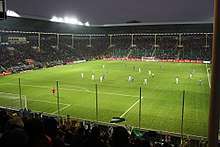
There are two nationally renowned football clubs in Mannheim, SV Waldhof Mannheim, who currently are playing in the third tier 3. Liga, but who have played in the top tier, the Bundesliga; and VfR Mannheim, winner of the German championship in 1949, now playing in the sixth tier Verbandsliga Baden.
The Adler Mannheim (formerly MERC, Mannheimer Eis- und Rollsport-Club) is an ice hockey team playing in the professional Deutsche Eishockey Liga, having won the German championship a total of eight times (7 times Deutsche Eishockey Liga and one time the former highest German ice hockey league known as Bundesliga).
The city is home to the Mannheim Tornados, the oldest operational baseball and softball club in Germany. The Tornados play in the first division of the Baseball Bundesliga and have won the championship 11 times, more than any other club.[23]
In 2003, the American football club MTG Rhein-Neckar Bandits was founded. The Bandits are playing in the first German Football League which is called GFL1. In the summer about 500 people watch each game.
Rhein-Neckar-Loewen (Lions) are a handball team (formerly SG Kronau-Oestringen) playing in the professional German Handball League.
The WWE visited Mannheim in 2008 and grossed more than half a million dollars with over 6,500 fans attending the event.
UFC fighter Dennis Siver lives and trains in Mannheim.
Mannheim hosted the European Show Jumping Championships in 1997, and the FEI European Jumping Championships in 2007[24] 14–19 August, in the MVV-riding stadium.
In 2002, Hobby Horse Polo was invented in Mannheim, evoking the classical rivalry towards "polite society" in Heidelberg.[25][26][27]
Block numbering and computer mapping
The center of the city uses an addressing system unique within Germany. Rather than street names and numbers, each block is given a code and a number is given to each building, i.e. C3, 17 is block C3, building 17. This practice dates back centuries, and is a result of the original use of the city center as a fort, with the fort's internal system being adopted when it became public streets. The street themselves are unnamed. The codes are laid out in a simple progressive pattern, i.e. C3 is between C2 and C4 in one direction and B3 and D3 in the other, but those unused to the system will often become lost. A street named Breite Straße goes through the middle of the blocks from south to north, with blocks A-K on the west side of the street and L-U on the east, with each row going 1 to at most 7 based on distance from this road. House numbers begin on the south corner nearest Breite Straße and go counterclockwise for A-K and Clockwise for L-U.[28]
This causes major issues with most mapping software, as the databases they use are based on the standard street-number system, and thus aren't able to accommodate a completely different system for a small area. A variety of fixes have been tried, none with a high level of success. In particular, these systems have issues because an address on a block can be on any of up to 4 roads, so attempts to fix the issue by giving the roads false names within the database have often failed to give accurate addressing, though such can still be seen on some platforms, like Google Maps. Finding an address in this area thus generally requires resorting to asking directions or using one of the many posted public maps.[29]
International relations
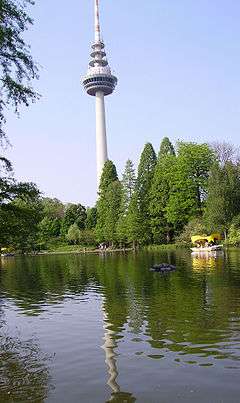
Notable people from Mannheim
See also: List of notable people from Mannheim
- 1748: Josepha von Heydeck, mistress of Charles Theodore, Elector of Bavaria
- 1771: Johann Baptist Cramer, composer and violinist (24 February)
- 1821: Friedrich Engelhorn, founder of BASF
- 1840: Richard von Krafft-Ebing, psychiatrist
- 1856: Henry Morgenthau, Sr., U.S. politician and real estate investor
- 1865: Robert Kahn, composer, pianist and music teacher
- 1867: Otto H. Kahn, investment banker, collector, philanthropist and patron of the arts
- 1887: Emmy Wehlen, musical comedy actress and silent screen star
- 1897: Sepp Herberger, coach of the German national soccer team 1936–1964 ("The Miracle of Bern", world champion with his team in 1954)
- 1898: Wilhelm Fuchs (1898–1947), Nazi SS officer and Holocaust perpetrator executed for war crimes
- 1905: Albert Speer, Nazi architect, Minister for Armaments and Munitions during World War II
- 1913: Hans Filbinger, German politician
- 1928: Samuel Hans Adler, German-American Composer, conductor, professor, founder of the Seventh Army Symphony Orchestra[31]
- 1934: Wolf Wolfensberger, German-American psychologist, pioneering in the area of services to people with disabilities
- 1937: Rudi Altig, cyclist
- 1931: Claus Leininger (1931–2005), theatre director and manager
- 1939: Christiane Schmidtmer, Hollywood actress
- 1946: Fred Breinersdorfer, writer
- 1956: Peter Dani, soccer player-Fortuna Düsseldorf-1975-1976-U.S. national team in 1976
- 1960: Norbert Schwefel, musician
- 1961: Juergen Adams, ice hockey player
- 1962: Uwe Rahn, football player
- 1965: Christine Lambrecht, politician (SPD)
- 1966: Franz Jung, Roman Catholic bishop
- 1969: Steffi Graf, tennis player
- 1971: Xavier Naidoo, pop singer
- 1972: Christian Wörns, football player for Borussia Dortmund and formerly Germany
- 1974: Lexi Alexander, director
- 1976: Bülent Ceylan, German-Turkish comedian
- 1977: Jochen Hecht, Buffalo Sabres, National Hockey League
- 1986: Uwe Gensheimer, Paris Saint-German, LNH Division 1
- 1990: Giulia Enders, medical researcher[32]
- 1994: Hakan Çalhanoğlu, Turkish footballer
Notes and references
- "Bevölkerung nach Nationalität und Geschlecht am 31. Dezember 2018". Statistisches Landesamt Baden-Württemberg (in German). July 2019.
- "Rhine-Neckar: Rhine-Neckar in figures". 7 July 2015. Archived from the original on 31 August 2014.
- "Metropolregion Rhein-Neckar". M-r-n.com. Archived from the original on 11 November 2013. Retrieved 13 February 2014.
- "World's 15 Most Inventive Cities". Forbes.com. Retrieved 13 February 2014.
- "The Manhattan of Germany: the innovative Mannheim city". The New Economy. Retrieved 23 March 2014.
- "The rise of the smart city". The New Economy. Retrieved 23 March 2014.
- "Mannheim ist jetzt offiziell "Unesco City of Music"" (in German). RNZ. Archived from the original on 28 December 2014. Retrieved 29 May 2016.
- "Smart City knows who needs power, and when". CNN. Retrieved 31 May 2016.
- Sonja Steiner-Welz, 400 Jahre Stadt Mannheim (Dokumente zur Stadtgeschichte). Band 1: bis zur Kaiserzeit, vol. 1, 2004, ISBN 978-3-936041-96-5, p. 41.
- Germany and the Second World War. Books.google.com. 15 November 2001. ISBN 978-0-19-822888-2. Retrieved 7 April 2011.
- Stanton, Shelby, World War II Order of Battle: An Encyclopedic Reference to U.S. Army Ground Forces from Battalion through Division, 1939-1946 (Revised Edition, 2006), Stackpole Books.
- Link
- "Staatsangehörigkeiten der Ausländerinnen und Ausländer zum 31.12.2017". Retrieved 18 June 2018.
- "Stadt Mannheim: Gemeinderatswahl 2019" (in German). Statistisches Landesamt Baden-Württemberg. Retrieved 9 August 2020.
- USAG BADEN-WÜRTTEMBERG PUBLIC AFFAIRS (9 June 2011). "Mannheim Deactivation Ceremony".
- "Archived copy". Archived from the original on 23 September 2007. Retrieved 7 June 2007.CS1 maint: archived copy as title (link)
- Casebeer, Elizabeth. "Mannheim Elementary closes doors after 66 years: Teachers, students all attend ceremony to say goodb." U.S. Army. 14 June 2012. Retrieved on 16 November 2015.
- Montgomery, Nancy. "Closing of bases in Mannheim ends special relationship between Germans, U.S. troops." Stars and Stripes. 22 May 2011. Retrieved on 16 November 2015.
- "Ausgabe der Klimadaten: Monatswerte". |date=July 2014 |source 2= "Dekadenrekorde".
- "Heidelberg historic weather averages". weather-online. Retrieved 13 August 2020.
- "Mannheim, Germany Köppen Climate Classification (Weatherbase)". Weatherbase.
- "Press release announcing the merger to form RNV (German-language)". 23 September 2009. Archived from the original on 19 July 2011. Retrieved 6 October 2009.
- "FEI European Jumping Championship, Mannheim". Em2007.de. Archived from the original on 18 July 2011. Retrieved 7 April 2011.
- Express 23 June 2013
- "Rheinpfalz July 25 2008".
- Eva Gerten, dpa (27 September 2014). "Steckenpferdpolo: Trendsportart in Düsseldorf im Rheinpark". SPIEGEL ONLINE.
- "Mannheim, Germany - 7 Awesome Things To Do". twomonkeystravelgroup.com.
- Tom Scott (19 February 2018). "The European City Centre With No Street Names" – via YouTube.
- "Partner- und Freundesstädte". mannheim.de (in German). Mannheim. Retrieved 26 November 2019.
- Milken Archive of Jewish Music - Samuel Adler Biography on milkenarchive.org
- Coburn, Jesse (15 January 2017). "A German Writer Translates a Puzzling Illness Into a Best-Selling Book". The New York Times.
Further reading
- Wiederkehr, Gustav: Mannheim in Sage und Geschichte, H. Haas'schen Buchdruckerei, 1907, (Festgabe zur Feier des dreihundertjährigen Bestehens der Stadt)
- David, Manfred: Mannheimer Stadtkunde. Edition Quadrat, Mannheim 1982, ISBN 3-87804-125-X.
- Staatl. Archivverwaltung Baden-Württemberg in Verbindung mit d. Städten u. d. Landkreisen Heidelberg u. Mannheim (Hrsg.): Die Stadt- und die Landkreise Heidelberg und Mannheim: Amtliche Kreisbeschreibung. Band 1: Allgemeiner Teil. Karlsruhe 1966, DNB 458203858. Band 3: Die Stadt Mannheim und die Gemeinden des Landkreises Mannheim. Karlsruhe 1970, DNB 366145509.
- Landesarchivdirektion Baden-Württemberg (Hrsg.): Das Land Baden-Württemberg – Amtliche Beschreibung nach Kreisen und Gemeinden. Band V.
- Kohlhammer Verlag, Stuttgart 1976, ISBN 3-17-002542-2.
- Huth, Hans: Die Kunstdenkmäler des Stadtkreises Mannheim. München 1982, ISBN 3-422-00556-0.
- Oesterreich, Carmen And Volker (Hrsg.): Mannheim, wo es am schönsten ist – 55 Lieblingsplätze. Berlin 2008, ISBN 978-3-936962-43-7.
- Schenk, Andreas: Mannheim und seine Bauten 1907–2007. Hrsg. v. Stadtarchiv Mannheim und Mannheimer Architektur- und Bauarchiv e. V. 5 Bde. Edition Quadrat, Mannheim 2000–2007, ISBN 3-923003-83-8.
- Walz, Guido (Red.): Der Brockhaus Mannheim. 400 Jahre Quadratestadt – Das Lexikon. Bibliographisches Institut & F. A. Brockhaus, Mannheim 2006, ISBN 3-7653-0181-7
- Naturführer Mannheim. Entdeckungen im Quadrat. Hrsg. von der Stadt Mannheim und der Bezirksstelle für Naturschutz und Landschaftspflege Karlsruhe. Verlag Regionalkultur, Ubstadt-Weiher 2000, ISBN 3-89735-132-3.
- Ellrich, Hartmut: Mannheim. Sutton, Erfurt 2007, ISBN 978-3-86680-148-6.
- Nieß, Ulrich and Caroli, Michael (Hrsg.): Geschichte der Stadt Mannheim. Verlag Regionalkultur, Ubstadt-Weiher, Band 1: 2007, ISBN 978-3-89735-470-8. Band 2: 2007, ISBN 978-3-89735-471-5. Band 3: 2009, ISBN 978-3-89735-472-2.
- Mannheimer Altertumsverein/Reiss-Engelhorn-Museen: Mannheim vor der Stadtgründung – Teile I und II. Hrsg. Hansjörg Probst, 4 Bände. Mannheim 2007/08, ISBN 978-3-7917-2074-6.
- Vetter, Roland "Kein Stein soll auf dem andern bleiben" Mannheims Untergang während des Pfälzischen Erbfolgekrieges im Spiegel französischer Kriegsberichte ISBN 3-89735-204-4
External links
| Wikimedia Commons has media related to Mannheim. |
- Official page of Mannheim
- Mannheim - official tourism website

- Rhein-Neckar Metropoliten Region Visitors' Site
- Verkehrsverbund Rhein-Neckar (Rhine-Neckar Transport)
- Parks in Mannheim
- Bertha Benz Memorial Route
- U.S. Army Garrison Mannheim homepage
- CNN: 'Smart City' knows who needs power, and when
- The Mannheim Heritage of World Cultures
